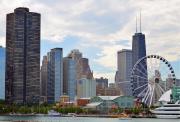Engaging with Residents on Water Conservation and Affordability in Santa Barbara
Everyone has a right to a safe and affordable water supply. However, many communities are experiencing rising water costs due to factors such as aging infrastructure, climate change and extreme weather events, inflation, and population declines. As water becomes more expensive, not all community members are impacted in the same way. Low-income households, senior or fixed-income households, renters, and people of color, among other historically marginalized communities, are disproportionately impacted by increases in water and wastewater rates, changes to water quality, and water shortages.
Water affordability is an environmental justice and equity issue. To ensure that rising water costs do not exacerbate environmental justice issues, the responsibility of water utilities is two-fold:
- Understand how rising costs impact community members across demographics,
- Ensure that actions taken to address water affordability challenges are tailored to the needs of the most vulnerable.
In the Alliance for Water Efficiency’s latest water affordability assessment, we partnered with the City of Santa Barbara to address these questions and understand the role that water conservation and efficiency can play to improve both water affordability and equity outcomes in the City.
And who better to ask than the community itself? Building from a previous Water Vision Community Engagement Campaign in the City of Santa Barbara in 2020, AWE and the City hosted a series of community engagement opportunities to better understand the local perspective on what water affordability challenges residents are facing as well as what kind of solutions are in line with community values and needs.
Here’s what we learned from community members in Santa Barbara:
 Water affordability is one piece of the larger cost of living challenges faced by residents. Individuals are juggling monthly water bills alongside other expenses from daily life, including other utility bills, rent, groceries, childcare, and more. Water bills, while contributing to the challenge, might not be top of mind for many. Community members and customers need clear and consistent education on water affordability, water conservation, and the resources available to them so they are better equipped to manage their bills and water use.
Water affordability is one piece of the larger cost of living challenges faced by residents. Individuals are juggling monthly water bills alongside other expenses from daily life, including other utility bills, rent, groceries, childcare, and more. Water bills, while contributing to the challenge, might not be top of mind for many. Community members and customers need clear and consistent education on water affordability, water conservation, and the resources available to them so they are better equipped to manage their bills and water use.
C ommunity members feel concerned about how water supply challenges from extended droughts, population growth, and future climate change impacts may increase their water bills and their ability to access water resources.
ommunity members feel concerned about how water supply challenges from extended droughts, population growth, and future climate change impacts may increase their water bills and their ability to access water resources.
 When asked what solutions could help improve water affordability, the community places significant emphasis on increasing outreach and education to ensure that residents, particularly those who are vulnerable, have improved access to and understanding of water bills and usage information.
When asked what solutions could help improve water affordability, the community places significant emphasis on increasing outreach and education to ensure that residents, particularly those who are vulnerable, have improved access to and understanding of water bills and usage information.
 Community members feel that water bills seem high despite their efforts to conserve, and that their monthly bill does not seem reflective of individual household use.
Community members feel that water bills seem high despite their efforts to conserve, and that their monthly bill does not seem reflective of individual household use.
How to utilize this kind of community feedback?
- To inform policies, programs, and initiatives. While every individual’s lived experience is unique, it is likely that those facing water affordability challenges have similar perspectives and concerns. Understanding the barriers and solutions that are top of mind to residents in this way serves as a decision-making framework for your organization to effectively manage and address water affordability challenges.
- As a starting point to improve future community engagement and outreach efforts. The engagement strategies used within this project’s timeline were successful in gathering feedback from older residents on fixed incomes but, despite significant outreach efforts, were not successful in generating input from Spanish-speaking populations or multi-family/renter populations. As the City continues engaging with community members on this topic, they can evaluate the outcomes from this project to adjust and tailor future strategies.
Thinking about engaging your community on water affordability? Here are some lessons learned:
 Start from the ground up. Working with a stakeholder group network comprised of local organizations and community representatives can be an effective way to reach individual residents as they help build trust with historically marginalized communities, advocate for those who may not have the capacity to represent themselves, and serve as information liaisons to individual residents.
Start from the ground up. Working with a stakeholder group network comprised of local organizations and community representatives can be an effective way to reach individual residents as they help build trust with historically marginalized communities, advocate for those who may not have the capacity to represent themselves, and serve as information liaisons to individual residents.
 Achieving the sweet spot where words turn to action. Translating outreach materials is a good first step to improving language accessibility, but access may not always translate to engagement. For example, where some communities are active online, others may prefer face-to-face interactions or to work through a trusted community partner. Exploring how specific communities receive information and relate to the issue topic can help organizations craft messages that not only reach residents but resonate with them well.
Achieving the sweet spot where words turn to action. Translating outreach materials is a good first step to improving language accessibility, but access may not always translate to engagement. For example, where some communities are active online, others may prefer face-to-face interactions or to work through a trusted community partner. Exploring how specific communities receive information and relate to the issue topic can help organizations craft messages that not only reach residents but resonate with them well.
 Meet people where they are...but then walk together to where you want to go. When residents feel recognized as partners and fellow experts, they may be more likely to get involved, advocate for solutions, and be stewards of their water use and bills. Building this level of trust with historically marginalized communities will require dedicated staff time and intention. This may look like compensating residents for their time and input; being mindful of work schedules, childcare, and transportation access when planning community meetings; finding opportunities to collaborate on existing community activities; and more.
Meet people where they are...but then walk together to where you want to go. When residents feel recognized as partners and fellow experts, they may be more likely to get involved, advocate for solutions, and be stewards of their water use and bills. Building this level of trust with historically marginalized communities will require dedicated staff time and intention. This may look like compensating residents for their time and input; being mindful of work schedules, childcare, and transportation access when planning community meetings; finding opportunities to collaborate on existing community activities; and more.
Want to dig deeper into this topic? Register today to join AWE, the City of Santa Barbara, Pacific Institute, CommUnify, and Ecology Action for the May 1, 2024, Water Affordability, Equity, and Conservation Roundtable!





